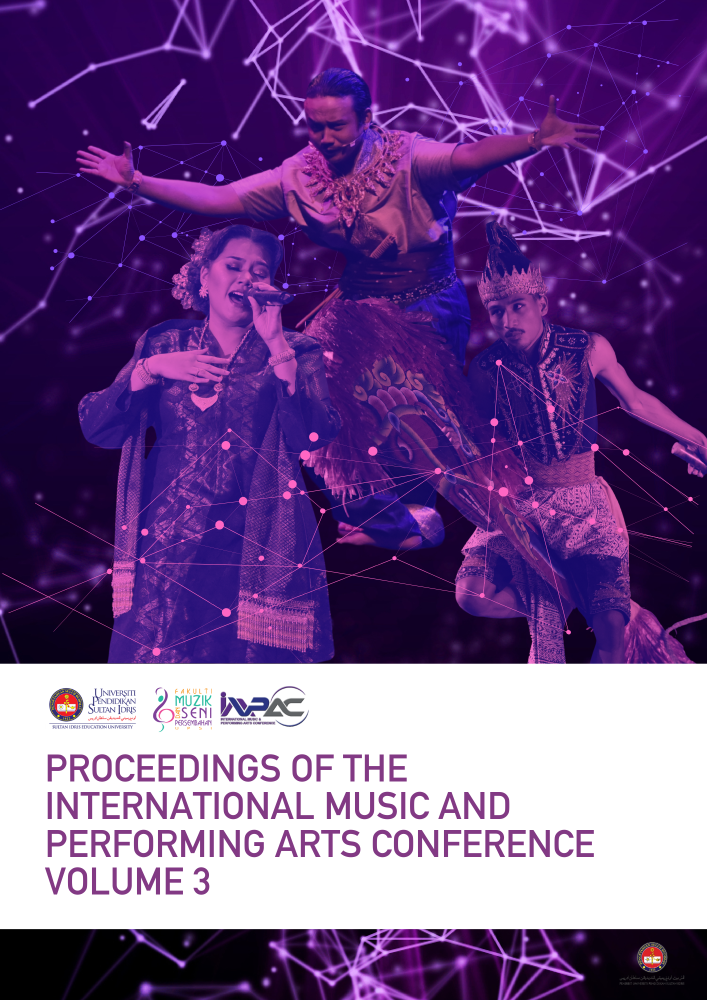Idealisation through the Conceptualisation of Traditopia Album: Nukilan Etnografi
DOI:
https://doi.org/10.37134/impac.v3.3.2025Keywords:
cultural identity, innovation, modernisationAbstract
Malaysian music has continuously evolved, flourishing locally and globally from both independent and mainstream labels, developing a positive transformation and serving as a platform for artist reflection and musical perspectives. It has become a well-known musical identity, showcasing musical nuances that blend the idea of modernisation and preserving culture. On the contrary, language and cultural practices may be a challenge for international listeners, making it daunting to connect or fully understand and appreciate the music. This disadvantage may interfere with the aptitude for cross-cultural recognition. The Traditopia album positions itself within this continuum, demonstrating how modernisation preserves and reshapes cultural identity through an insightful approach from the project director, shaping the direction of musical nuances in nine original tracks. Traditopia examines the conceptual framework of Nukilan Etnografi, an innovative Malaysian music project that combines traditional Malaysian, western classical, and jazz elements to highlight the country’s cultural diversity, with the purpose of affirming the belief that modernisation need not erase tradition; instead, it can provide a platform for traditional sounds to resonate within a broader, contemporary context within the performing arts. This study reviews the objectives of the creative intentions behind the project, focusing on how the compositional works reflect the director’s vision. Drawing on literature reviews and primary sources, the research reveals that Traditopia serves as both a tribute to traditional Malaysian sounds and a reinterpretation of these sounds through a modern lens, intended to bridge traditional and contemporary musical forms.
Downloads
References
Bello, J. P., Chew, E., & Turnbull, D. (2008). ISMIR 2008: Proceedings of the 9th International Conference of Music Information Retrieval. Lulu.com.
Chopyak, J. (2007). Globalisation, Westernization and Islamic Influence in Music in Malaysia. SciSpace - Paper. https://typeset.io/papers/globalization-westernization-and-islamic-influence-in-music-1slmg9x4wq
Doraisamy, S., Golzari, S., Norowi, N. M., Sulaiman, M. N., & Udzir, N. I. (2008). A study on feature selection and classification techniques for automatic genre classification of traditional Malay music. International Symposium/Conference on Music Information Retrieval, 331–336. http://ismir2008.ismir.net/papers/ISMIR2008_256.pdf
Geiser, E., Sandmann, P., Jäncke, L., & Meyer, M. (2010). Refinement of metre perception – training increases hierarchical metre processing. European Journal of Neuroscience, 32(11), 1979–1985. https://doi.org/10.1111/j.1460-9568.2010.07462.x
Halid, R. I. B. R. (2022). The Music of Malaysia: The Classical, Folk, and Syncretic Traditions by Patricia Matusky and Tan Sooi Beng. Asian Music, 53(2), 150–153. https://doi.org/10.1353/amu.2022.0018
Ismail, M. J., & Loo, F. C. (2023). The evolvement of Syncretic Music: The Aesthetic Values of Malaysian Popular and Traditional Music. Studia Universitatis Babeş-Bolyai Musica, 68(Sp.Iss. 2), 87–105. https://doi.org/10.24193/subbmusica.2023.spiss2.06
Klein, S. (n.d.). The Development of the Concept Album. ScholarWorks@GVSU. https://scholarworks.gvsu.edu/honorsprojects/761
Maestri, E. (2020). An Exploratory Inquiry into the Relationship between Temporality and Composition. Organised Sound, 25(2), 179–186. https://doi.org/10.1017/s1355771820000084
Stein, D., & Spillman, R. (1996). Temporality. In Poetry into Song: Performance and Analysis of Lieder (online ed, pp. 69–80). Oxford Academic. https://doi.org/10.1093/oso/9780195093285.003.0004
Downloads
Published
Issue
Section
License
Copyright (c) 2025 Siti Nur Hajarul Aswad Shakeeb Arsalaan Bajunid, Rizal Ezuan Zulkifly Tony (Author)

This work is licensed under a Creative Commons Attribution 4.0 International License.
Authors retain copyright and grant the Proceedings of the International Music and Performing Arts Conference (IMPAC Proceedings) the right of first publication.
This licence permits unrestricted use, distribution, and reproduction in any medium, provided the original work is properly cited.





